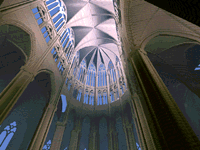

SEEING THE FUTURE:
Visualization in architecture
and beyond
ON THE 12TH FLOOR of Columbia's
Engineering Building is the cyberspace classroom for the architects of the next century.
Here a student can tour the elegant Cathedral of Amiens (1) or disassemble Mies van der Rohe's all-glass
Farnsworth House down to the rafters and then redesign it, using his or her own
ideas. Special software lets users fly through this 3-D world to different parts of the building,
pausing behind beams and columns to see how they are put together.  Welcome to Gateway Labs, a state-of-the-art facility
representing a partnership between Columbia and the
National Science Foundation, where a student can use 3-D visualization to build
bridges, develop space stations, invent machines, and even animate dinosaurs. The walls are
covered with colorful renderings that range from the reconstruction of the renowned 15th
century DaVincian anatomical man to a student's rendition of the Columbia crown. The lab,
which itself was designed by computer, recently was the site of some production work on
Stephen King's new ABC miniseries "Langoliers", which is about round, supernatural creatures with teeth, who like to disrupt
the lives of the citizenry.
Welcome to Gateway Labs, a state-of-the-art facility
representing a partnership between Columbia and the
National Science Foundation, where a student can use 3-D visualization to build
bridges, develop space stations, invent machines, and even animate dinosaurs. The walls are
covered with colorful renderings that range from the reconstruction of the renowned 15th
century DaVincian anatomical man to a student's rendition of the Columbia crown. The lab,
which itself was designed by computer, recently was the site of some production work on
Stephen King's new ABC miniseries "Langoliers", which is about round, supernatural creatures with teeth, who like to disrupt
the lives of the citizenry.
The architectural video room is one of several new multimedia classrooms in the design or conceptual stage throughout Columbia. Dr. Nicholas Turro has a multimedia laboratory for chemistry students; the journalism school is building a Center for New Media, bringing all communication technologies together under one roof; and Conrad Johnson of the Law School advocates developing what he calls the Courtroom of the Future, which would incorporate video screens to display transcripts and computer-generated re-enactments of events.
Scientists in various fields also foresee visualization technology moving in the direction of manipulating objects in a virtual world and at the same time reacting with the real world.Steven Feiner's"augmented reality" system, he says, enriches rather than replaces the real world. For example, he has worked with head-worn, see-through displays that explain a complex 3-D task such as the maintenance and repair of a laser printer. This model, known as KARMA (Knowledge-based Augmented Reality for Maintenance Assistance), establishes a method so the viewer can see what is happening inside the machine as one performs different tasks. The user sees the machine in the real world, but the maintenance operation occurs in the virtual world.
Perhaps this concept of reality augmentation holds an implicit answer to the questions posed by critics of the visual revolution. Platonists feared images because they could destabilize our sense of reality, but technologies that put images in the service of reality hardly threaten our ability to make sense of the world. As visualization matures into a vibrant interdisciplinary field, merging academic inquiry with industrial advances, these approaches bring our species closer to reality, continuing to expand our optical and neural capabilities, and others still unimagined.
-
The Amiens Project is a collaboration
between the Department of Art
History and Archaeology and the Digital Design Laboratory of the Graduate School of Architecture, Planning and
Preservation. It is funded by the National
Endowment for Humanities.




